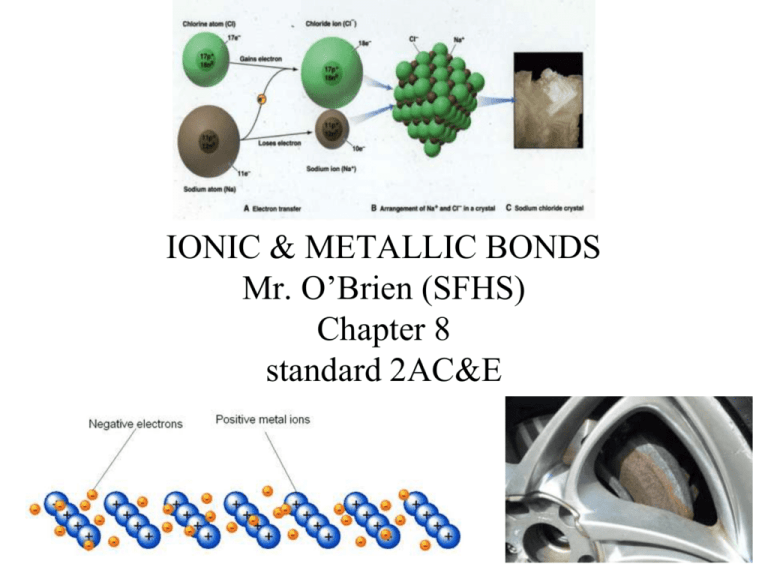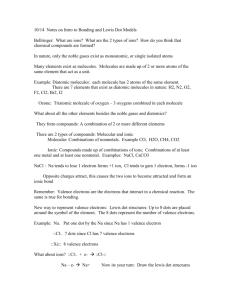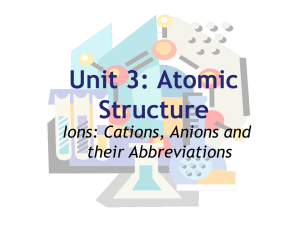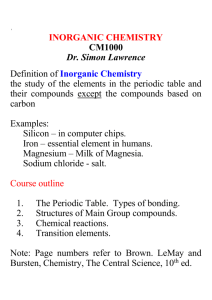Ionic Bonds
advertisement

IONIC & METALLIC BONDS Mr. O’Brien (SFHS) Chapter 8 standard 2AC&E Review Formation of cations & anions • What do all elements want to be like? Checking for Understanding Identify whether the following will form an anion or a cation and write their ionic symbol. Potassium Beryllium Phosphorus Oxygen Fluorine – Noble Gases (full outer shell of 8ve) • What will all other elements do to be like NG? – Gain, lose, or share ve. – Atoms turn into ions. • How do atoms become cations? • How do atoms become anions? – When an atom loses 1 or more valence é – When an atom gains 1 or more valence e, it becomes an anion. Sodium (Atom) 11p+ 11e- = 0 Chlorine (Atom) 17p+ 17e- = 0 Sodium (Cation) 11p+ 10e- = +1 Na+1 Chlorine (Anion) 17p+ 18e- = -1 Cl-1 Review Electronegativity & Ionization Energy •non-metals •gain valence electrons •high electronegativity (attractive) Checking for Understanding What type of elements form cations? Explain using your knowledge of IONIZATION ENERGY why cations form (+) ions. What type of elements form anions? Explain using your knowledge of ELECTRONEGATIVYTY why anions form (-) ions. •metals •lose valence electrons •low ionization energy (weak) Formation & Properties of an IONIC BONDS (std.2A&C) Key Terms Electrostatic force (attraction between cations (+) and anions (-) Salt Solid ionic compounds What are ionic bonds composed of? – Metal (cations) and nonmetal (anions) elements How are ionic bonds formed? – by the transfer of valence electrons – metal atoms will lose their valence Checking for Understanding electrons TO the more attractive How can you tell these compounds nonmetal atoms. are Ionic bonds? – These ions are then held together by NaCl, MgCl , CaO, Li N, Na (SO ) 2 3 2 4 electrostatic force Explain the ratios of ions in each compound above. 1:1 Na+1:Cl-1 Formation & Properties of an IONIC BONDS (std.2A&C) What shape is are ionic solids? – Crystal Lattice (cubic) structure. – Repeating patterns of cations (+) and anions (-). Why does a Crystal Lattice work? • There’s enough space between ions so they don’t repel. How do we measure the strength of the crystal lattice? – Lattice energy (energy required to separate ions of an ionic compound) HONORS: Factors of Lattice Energy: 1. Size of ions (smaller ions have more lattice energy) 2. Charge of ions: (ionic bonds with ions of larger oxidation numbers (charges), have more lattice energy) Checking for Understanding What pattern do you notice in the lattice energies of sodium salts? Can you predict the order of the following potassium salts from strongest to weakest salt. KI, KBr, KF, KCl Formation & Properties of Ionic Bonds (std.2A&C) What are Properties of ionic bonds: • • • What are Electrolytes??? Liquid solution that contains FREE ions that move randomly in the solution. This solution (electrolyte) can now conduct electricity because ions are able to move. Hard, rigid, and brittle crystal solids As solids high melting/boiling points Conductive when dissolved in liquids, (the bonds break apart into ions forming electrolytes) NO CURRENT Ions “STUCK” FYI Sugar (non-ionic) melts at 135oC CURRENT Ions move in liquid and carry electricity Lewis Dot Structures for Ionic Bonds (std.2E) Why are Lewis Dot Structures used? – To show valence electrons! How to draw Lewis Dot Structures for Ionic Bonds? 1. Draw e dot structures for each atom. 2. The more electronegative atom will “steal” an electron from the other. Move the electrons. 3. Write charges above the ions. note: anions will have octets while the cations have no ve (figure 1) Note that atoms are neutral when they contain their valence electrons. When they lose or gain valence electrons, then charges must be written. What’s wrong with the animation below? Can opposite charged ions be next to each other? Checking for Understanding Draw the Lewis Dot Structure for each LiCl Li2O MgF2 AlF3 (See above) Writing Ionic Formulas (HONORS) What are formulas? – Subscripts show the ratio of ions in each compound. Examples of Writing Formulas How do you make an ionic formula? – Write cation (symbol & charge) – Write anion (symbol & charge) Total charges of ions (cations &anions) must EQUAL zero. Use subscripts to show amount of ion for each Use parentheses to group polyatomic ions together. Magnesium & Oxygen Mg+2 O-2 = charges equal zero MgO Aluminum & Fluorine Al+3 F-1 ⇨ Al+3 F(-1)3 AlF3 Calcium & Nitrate Ca+2 NO3-1 ⇨ Ca+2 NO3(-1)2 Ca(NO3)2 Checking for Understanding Write the formula for the following? (Lithium &Oxygen) (Gallium& Bromine) (Potassium & Sulfate) (Ammonium & Sulfur) Writing Names of Ionic Compounds (honors) How to write names of simple ionic compounds? 1. Write name of cation Example of Simple Ionic Comounds: NaCl (sodium chloride) 2. Write name of anion MgO (magnesium oxide) 3. Change ending of anion to “ide” How to write names with polyatomic ions? 1. Write name of cation Example with Polyatomic ions: NaNO3 (sodium nitrate) 2. Write name of polyatomic ion Mg3(PO4) (magnesium phosphate) How to write names using transition metals? 1. Write name of cation 2. 3. Figure out its’ oxidation number and write roman numeral. Write name of anion (if anion from Periodic Table, write “ide” ending. Key Term Example with Transition metals: CuNO3 (copper (I) nitrate) Cu(NO3)2 (copper (II) nitrate) Oxidation Number Charge of an ion Checking for Understanding Write the names for the following? Li2O MgCl2 Al2S3 Na2SO4 NH4Cl H2O2 Be3(PO3) Metallic Bonds (std.2A) What types of elements form Metallic Bonds? Formed from ONLY metal atoms (cations). How are valence electrons exchanged in a Metallic Bond? Metal atoms contribute their valence electrons (delocalized electrons) to the group. If the metal atoms are all cations, how are they then held together? • (figure 1) Metallic bonds in a sample of silver. Note the silver cations can tolerate each other because they are attracted to the “roaming” valence electrons (delocalized electrons). Key Term Electron Sea Model Like water in a sea, valence electrons of metal atoms in a metallic bond are always in constant motion Metal atoms are attracted to the roaming Delocalized Electrons (figure 2&3) Animations showing the movement of delocalized valence electrons. Note that valenece electrons are not held by any specific atom and can easily move form one atom to the next. Metallic Bonds (Std.2A) What are a few properties of Metallic Bonding? – – – – – Malleable (bendable) Ductile (drawn into wire) (figure 1) Because the metal cations are attracted Good conductors to the delocalized electrons they can be bent or moved Lustrous (shiny) and still be part of the metal bond. High melting/boiling points (figure 4) Data table listing various melting points of metallic bonds. Note conventional ovens can reach limits of 250oC (figure 3) Since delocalized can move anywhere they can carry electricity across the metal bonds. (figure 2) Delocalized electrons absorb light energy (photons) and also release them. Thus metals look shiny.





